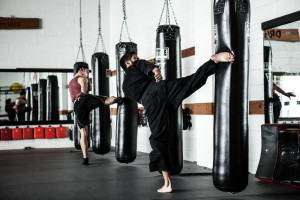 1. Train with lower intensity
1. Train with lower intensity
This may be surprising to hear from your instructor, but you have to keep in mind that you cannot be at 100% all the time. Arguably, you should almost never be training at 100%. As a martial arts trainee you should live between 40% and 80% intensity. Training below that is likely not challenging enough to incite adaptation and improvements.
High intensity exercise is definitely a great way to lose fat and gain muscle. However, getting into “good shape” is not our only goal. Our goal is to become better martial artists as well as increase our longevity. Remember, looking fit is not the same as being healthy. How you got “fit” will really determine how healthy you really are. As such, high intensity training sessions should be limited to 2 or 3 times per week at a maximum. Too many high intensity sessions will introduce too many stressors to the body, weaken the immune system and even disrupt sleep.
Additionally, as a Martial Arts Trainee, the intensity level of the exercise itself is not the only thing to consider. By definition, martial arts are high impact and contact activities. Are we operating in full contact mode all the time? Of course not, and that is exactly my point. If we practice too intensely all the time we will be more prone to getting “banged up”. While getting bumps and bruises may be a badge of honor, if they inhibit our practice and improvement, what good are they?
So, how to practice at lower intensity? Simply put, focus on practicing technique rather than getting a “work out”. There are a plethora of techniques to practice and you have to make priorities depending upon your particular style. For example, a hapkido student could practice wrist locks slowly and smoothly with a partner, a taekwondo student could practice kicks, a gracie jiu-jitsu student could practice slow flow-type rolling, and a muay thai student could practice slow jabs, crosses and other combinations in the mirror.
Remember, the goal is getting better, not getting tired.
How do you know if you’ve done too much, or too little? You need to journal your training, just like your food intake. That’s only way to for sure and over time how much training you have completed.
2. Train with a different partner
Typically we all train and attend classes on a regular schedule. Meaning we generally see the same instructors and training partners in every class. As a result,we tend to work with the same person, or few people all the time. This has many benefits. We develop a bond with our training partner that is stronger than a mere social connection. We know we can trust and rely on this person and that they will support us through our martial arts journey. This bond encourages us to train more often and the trust allows us to be more relaxed and receptive for applying techniques.
However, in some ways this consistency of training can be limiting or even counterproductive. If you have the same sparring partner all the time, you will get really good at sparring that person. Unfortunately, you are losing out on the stimulus of a different partner. Think about differences in speed, height, weight and strength that different partners could bring. Think about how you could improve your skills from this variety.
The benefits of changing partners every so often goes beyond improving sparring ability or technical applications. Every training partner also provides a different kind of energy to training. When you train with someone, you should think of yourself as their coach for the day and they are your coach for the day. Different kinds of encouragement and feedback are always helpful.
Lastly, you will have the opportunity to develop that training bond with someone you might not have.
3. Foam rolling
Many of you have asked me about foam rolling. Foam rolling before (and after) classes can provide you with many benefits. Foam rolling can be used to correct postural form and break down muscle adhesions and tightness. Not only will this reduce soreness and shorten muscle recovery time, it will increase range of motion if done before warm ups and stretching. Better posture, increased range of motion, less soreness, and shorter recovery times will all lead to a better physique, enhanced performance and better overall health.
What are the areas to foam roll?
Basically the entire musculature of the body can be rolled but there are certain areas to focus on and certain areas to avoid.
For now avoid:
– Ribs
– Low back
– Neck
Areas to focus on:
– IT Bands & Gluteals
– Adductors
– Pecs and Lats
– Quads and Hip Flexors
– Thoracic Spine (mid Back)
Remember, when foam rolling the muscle should be relaxed. Never roll to the point of pain, the muscle should feel just short of the pain threshold. This will help establish mobility in the muscle tissue. If foam rolling is a totally new concept for you, consider scheduling a Functional Movement Screen with me or one of the other instructors here.
Sincerely,
Somnath Sikdar
Master Instructor
Dragon Gym Martial Arts & Fitness
